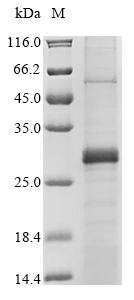The Recombinant Lassa virus Pre-glycoprotein polyprotein GP complex (GPC) is produced using an in vitro E.coli expression system, covering the amino acid region 259-490. This partial protein is N-terminally tagged with 10xHis, which appears to make purification and detection more straightforward. The product achieves a purity level greater than 85% as determined by SDS-PAGE, ensuring reliable use in research applications. This product is intended for research use only.
The Lassa virus Pre-glycoprotein polyprotein GP complex (GPC) seems to play a crucial role in the viral life cycle. It's involved in the maturation and function of the viral envelope glycoproteins - proteins that are essential for virus entry into host cells. This makes the GPC a potentially important target for understanding viral pathogenesis and investigating therapeutic interventions.
Potential Applications
Note: The applications listed below are based on what we know about this protein's biological functions, published research, and experience from experts in the field. However, we haven't fully tested all of these applications ourselves yet. We'd recommend running some preliminary tests first to make sure they work for your specific research goals.
Lassa virus GPC is a complex viral glycoprotein that requires precise folding, extensive disulfide bond formation, proper glycosylation, and trimerization for its functional activity in viral entry. The in vitro E. coli expression system cannot provide the necessary eukaryotic folding environment, oxidative conditions for disulfide bond formation, or glycosylation machinery required for this viral glycoprotein. The partial fragment (259-490aa) represents only a portion of the full glycoprotein and lacks critical structural domains. The N-terminal 10xHis-tag may sterically interfere with proper folding. The probability of correct folding with functional activity is extremely low.
1. Antibody Development and Epitope Mapping Studies
This application is highly suitable as antibody development primarily relies on linear epitope recognition rather than functional protein folding. The fragment (259-490aa) provides specific epitopes within this region for antibody production. However, antibodies may not recognize conformational or glycosylation-dependent epitopes present in the native viral glycoprotein.
2. ELISA-Based Binding Assays
This application is suitable for developing immunoassays to detect antibodies against linear epitopes but not for functional receptor binding studies. The protein can serve as a coating antigen for antibody detection assays, but it cannot model native glycoprotein-receptor interactions due to the lack of proper glycosylation and folding.
3. Biochemical Characterization and Structural Studies
Basic biophysical characterization can be performed, but will not reflect native glycoprotein structure. Techniques can analyze the physical properties of this specific fragment, but results will describe a non-glycosylated, misfolded protein rather than the native viral glycoprotein.
Final Recommendation & Action Plan
The in vitro E. coli expression system is fundamentally unsuitable for producing a functional Lassa virus glycoprotein due to its inability to provide proper glycosylation, disulfide bond formation, and complex folding required for viral glycoproteins. This recombinant GPC fragment is primarily suitable for Application 1 (antibody development against linear epitopes) and limited aspects of Applications 2 and 3 (immunoassay development and basic characterization). Avoid protein interaction studies entirely due to the high probability of misfolding and non-specific binding.






